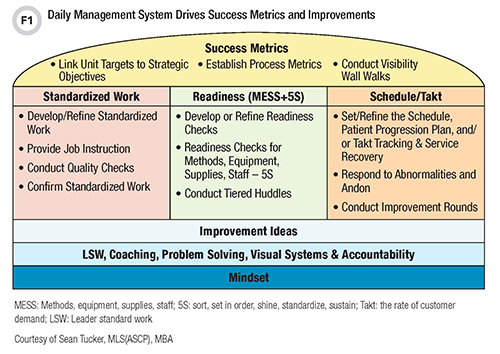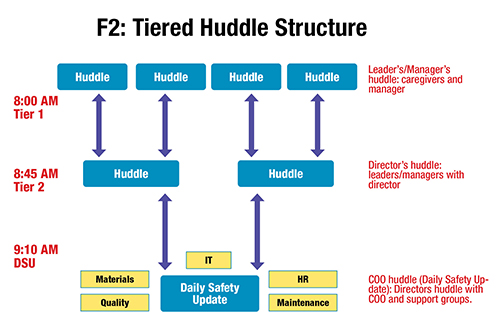Clinical laboratories are high-speed, complicated systems with diverse branches and resource needs. Increasing demand from our patients, clinicians, and administrators requires us to adapt to changes while maintaining consistent quality. Daily Management System (DMS) enables organizations to create common language, clear expectations, and systems for reporting, adjusting to, and improving workflow to ensure continual readiness. Children’s Mercy Kansas City has honed this lean process after 5 years of multidepartment work focusing on incorporating multiple laboratories into an overall departmental lean initiative.
Continual Readiness
DMS is an organizational daily structure designed to create transparency and standardization across departments, escalate problems quickly, review improvement metrics, inspire process improvement, and maintain continual readiness (Figure 1). This begins with all employees having a true north mindset: patient centered in every action, every day. From there, an organization can build standardized work, visual cues, and common language that work toward becoming a highly reliable organization.

The daily cadence encompasses a tiered huddle system that starts at the department level and progresses to a tier 3 daily safety update with hospital leaders (Figure 2). In these short 5-to 15-minute huddles, a department uses visual boards to quickly review daily volumes, situation awareness, department safety, equipment, staffing, and supply challenges. The huddle also includes reviewing improvement metrics, identifying and resolving problems that arise by escalating if necessary to the next tier huddle. Lastly, the huddle includes daily announcements and recognition.

Staffing challenges and equipment failures are common topics during huddles. Whenever we have staffing that cannot maintain customer needs or equipment failures that delay expected testing turnaround, we escalate issues up through hospital leadership so they’ll be aware, and when warranted, take actions to improve our situation. Examples of the latter would include approving open position requisitions or speeding up service contracts.
Standardizing Work; Creating Cadence
From the huddle, leaders go to their departments to visit staff, discuss issues, coach for improvement, review department metrics, and document any abnormalities from procedural standards. We recommend documenting step-by-step the standard work for a process and using this to educate team members, especially when processes and procedures differ. We use quick reference guides called Job Aids to support standard work in real time. We encourage leaders to audit staff, documenting their observations via an abnormality tracker, which ensures that standard work continues over time. In the language of lean practices, this time with front-line staff is called Gemba.
Understanding abnormalities in standard work allows teams to look quickly for systemic improvements and ensure a higher reliability of cadence in the service being provided. We calculate cadence based on the available work hours, the lead time of the process under consideration, and the demand from customers. This guides expectations for service throughput and productivity metrics for staffing needs. We focus on flow (of patients or work), what inhibits that flow and our response, and continuous improvement of that flow.
An example of how cadence plays out would be in our outpatient laboratory. If this lab expects to collect samples from 60 patients per day, it takes 30 minutes per patient, and the hours of operation are from 8 a.m.–6 p.m, then the cadence to maintain workflow would be (600 min/day)/(60 patients/day) = 10 min/patient. When it takes 30 minutes of cycle time per patient, then our cadence flow would be (30 min lead time)/(10 min takt* time) = 3 patients at any given time. With the need to draw three patients at any given time, we would need at least three staff members and three rooms for this operation.
To stay organized, employees use a document called leader standard work, which displays the tasks an employee needs to complete daily, weekly, and monthly and includes not only tasks but also goals and coaching records that help leaders improve transparency. Employees check off tasks in real time and leaders document conversations and progress. Managers and employees view this visual work template to spot progress and adjust direction.
Lessons Learned
A hospital’s continual readiness and ability to manage performance affect its operating risk, an overall enterprise risk. Leaders play an important role in reducing risk by increasing organizational agility. Supporting nimbleness within our current business while preparing for challenges ahead is the name of the game. Creating a transparent common language and visual resources to identify and improve abnormalities under a lean construct also provides leaders with more confidence in their ability to adapt to changes. DMS brings focus and predictability to what we do and ensures a patient-centered approach, every action, every day.
*rate of customer demand
The author will discuss this topic on December 14 during a roundtable talk (session number 52211) at the 2020 AACC Annual Scientific Meeting.
Sean Tucker, MLS(ASCP), MBA, is the limited services laboratories manager for the Children’s Mercy Kansas City department of pathology and laboratory medicine.+Email: [email protected]
Lori Stokes, MT(ASCP), is the laboratory supervisor at Children’s Mercy Kansas City East Clinics.+Email: [email protected]
The authors gratefully acknowledge the participation of Children’s Mercy performance improvement team members Felicity Pino and Tom Belt and laboratory lean implementation team members Toni Sheffer, Eugenio Taboada, Uttam Garg, Christina Vasquez, Deb Faller, Barbara Mouron, Diane Burford, Randah Althahabi, Marinda Cooper, Gabe Metzler, Trang C. Nguyen, Clint Frazee, Megan Gripka, and Lindsey Dodds.